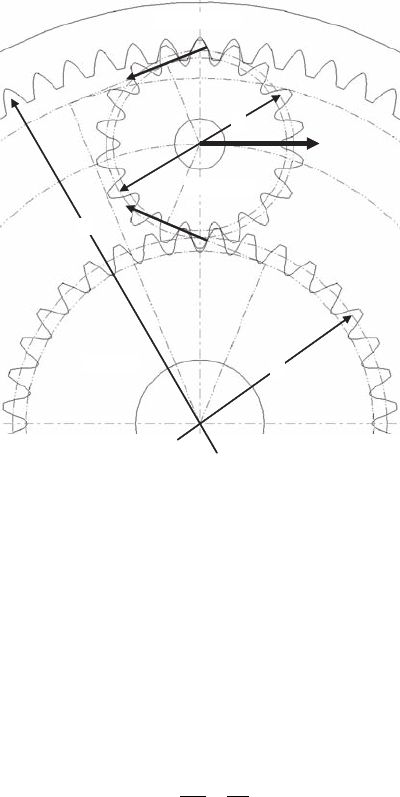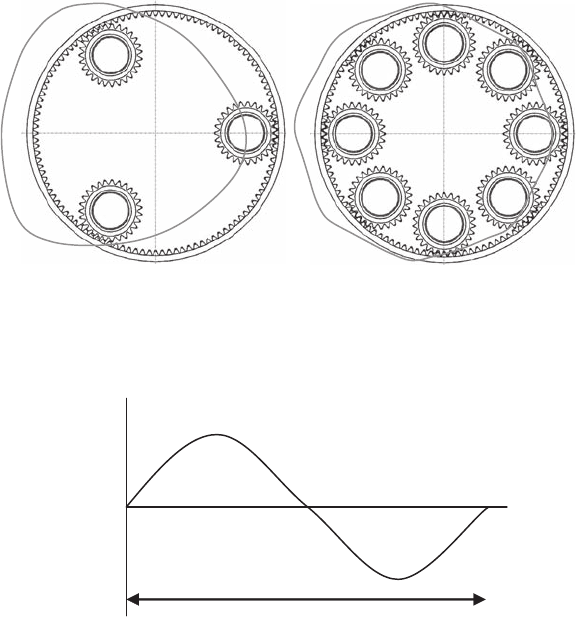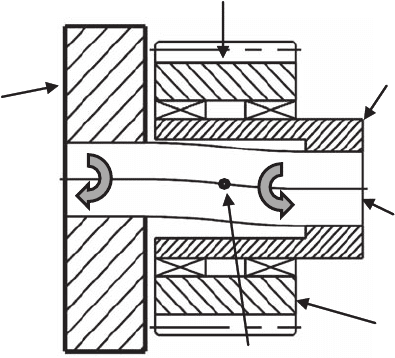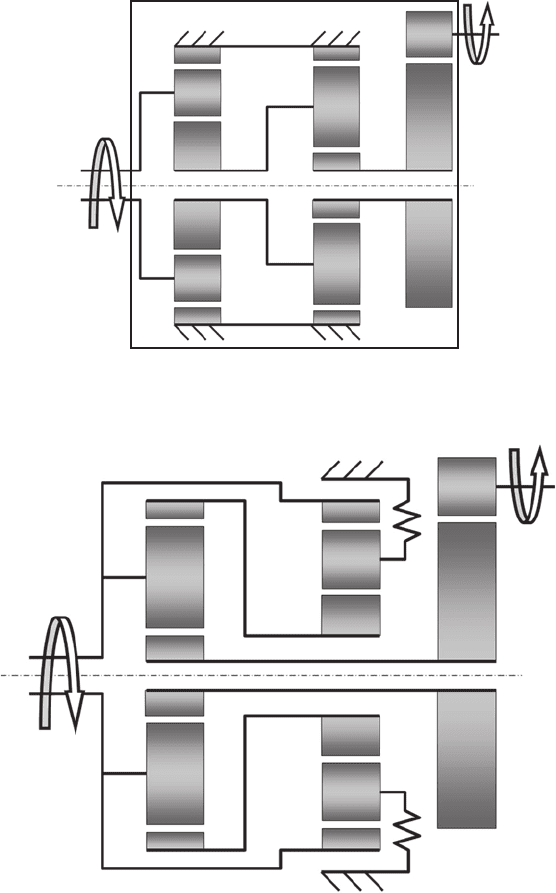Tong W. Wind Power Generation and Wind Turbine Design
Подождите немного. Документ загружается.


Optimized Gearbox Design 515
T
C=
fdm
(3 )
where m = module = d / N . Then,
2
TN
fd =
C
(4 )
where f , d and T are as before and N is the number of teeth.
By equating the surface and bending volumes derived as above, it is possible to
obtain a non-dimensional “optimum” number of pinion teeth based on the balance
of bending to surface criteria and the gear ratio viz. By comparing eqns (1) and (4),
it yields,
1
1
C
N= +
nK
⎛⎞
⎜⎟
⎝⎠
(5)
Since tooth number is unaffected by face width to diameter ratio or torque, it is
only necessary to choose a rounded down number compatible with the nearest
standard pitch and the required face width, diameter and ratio. Thus, root fi llet
stress is not usually a limiting criterion because the pitch is easily increased by
reducing the number of teeth. Nonetheless, there are big incentives for making
pitch as fi ne as possible.
A smaller pitch with bigger tooth numbers has a somewhat greater contact ratio 1.
but a shorter path of contact and commensurately lower tooth sliding veloci-
ties. This improves effi ciency and reduces sliding losses and associated sur-
face related problems such as scuffi ng. It also reduces surface stress slightly by
increasing the relative radius at the chosen load point.
For a given load, the reduced bending moment on the root of a shorter tooth 2.
means a thinner rim is required for its support. This is very important in epicyclic
gears as described later.
For simplicity, the foregoing consideration of gear geometry is confi ned to spur
rather than helical gears. The latter also embody tip relief to mitigate pitch error
problems as the teeth enter and leave the contact zone. However, experience sug-
gests that although they are generally quieter than spurs, they are both subject to
the same problems associated with the effects of parasitic loads and defl ections
and the helix corrections required to compensate for them. Unfortunately, such
corrections only work for one condition. Attempts to cater for varying conditions
by crowning the teeth, inevitably lead to higher stresses.
3 G eartrains
It is not practical to have a single stage gearbox to provide a step-up ratio of 100:1.
In practice, such an overall ratio invariably requires three stages. To minimise size

516 Wind Power Generation and Wind Turbine Design
and weight, particularly in the fi rst two, high torque low speed stages, it is usual to
employ epicyclic gearing in which load is shared via three or more parallel load paths.
As shown in Fig. 5 , such gears have the further advantage of having co-axial input and
output shafts rather than the offset parallel axes of a simple wheel and pinion.
The simplest form of epicyclic gear comprises three co-axial elements; a sun
wheel, a planet carrier, which provides a straddle mounting for a number of equi-
spaced planet wheels and an internally toothed ring gear or annulus. The fi gure
shows that the planet wheels serve as idlers (no residual torque) between the sun and
annulus wheels. If the planet carrier is fi xed, the sun and annulus rotate in opposite
directions, with the sun rotating at − R times the speed of the annulus where
aa
ss
Nd
R= =
Nd
(6 )
where N
a
and N
s
are the teeth numbers, and d
a
and d
s
are the pitch diameters of the
annulus (ring) and sun wheel, respectively.
It can be seen that the carrier has a torque reaction equal and opposite to the sum
of the sun and annulus torques. From this, it can be inferred that if the annulus is
fi xed then the sun will rotate at +( R + 1) times the speed of the carrier and in the
same direction .
Conventionally, most simple epicyclic gears have three planets and to ensure
equal load sharing the sun is allowed to fl oat so that it can fi nd an axis which ensures
its equilibrium and compensates for the collective errors in the concentricity of the
respective axes of the sun wheel, planet carrier and annulus. This therefore requires
a suitable fl exible coupling to transmit the sun wheel torque.
T
f
T
f
Planet
bearing
load
d
s
d
a
d
p
Sun
wheel
Planet
wheel
Annulus
wheel
Figure 5: Half section epicyclic gear.

Optimized Gearbox Design 517
Various solutions have been used to provide load sharing for epicyclic gears
having more than three planets. The most widely used have employed a fl exible
annulus ring which subject to its tooth forces defl ects as shown in Fig. 6 . However,
the maximum number of planets is usually limited to 6, because with greater num-
bers, load sharing becomes less effective as the defl ections decrease. Even though
more planets enable the ring thickness and weight to be appreciably reduced, it is
not enough to give the required defl ections without excessive stresses. In addition,
the planet spindles are straddle mounted in a carrier which requires rigid webs
between the planets to try and minimise its torsional wind up and the mal-distribution
across the meshing faces of the planet wheel teeth.
The main problem associated with fl exible annulus rings is that even with con-
stant torque, they are subject to fully reversed cyclic bending stresses due to the
outward and inward defl ections, with the passage of each planet (see Fig. 7 ).
The most logical location for fl exibility is in fact the planet spindle. Because it
serves as a mounting for an idler with zero torque, the relative load on the spindle
is always in a constant direction, whether or not the carrier is rotating. It follows
therefore that subject to constant torque, defl ection is static, and not subject to a
Figure 6 : Annulus ring bending defl ections. The defl ection curves should not be
offset laterally but located symmetrically so that they show the radial
inward and outward distortions of the respective 3 and 8 planet annulus
rings from their circular shapes.
Bending
stress
An
g
ular distance between planets
Figure 7: Cyclic stress reversals.

518 Wind Power Generation and Wind Turbine Design
primary fatigue condition. However, when torque is variable, there is clearly an
associated secondary unidirectional fatigue condition in the planet spindles as well
as the gear teeth. In any case, even with constant torque, sun and annulus gear teeth
are subject to unidirectional fatigue as they rotate, in and out of mesh with the
planet wheel whose teeth are subject to full fatigue load reversals as they alter-
nately mesh on opposite fl anks with the sun and annulus. Therefore, all gears
whether epicyclic or otherwise, have to be designed to accept primary fatigue
loads as well as the secondary effects of torque fl uctuation.
As stated previously, conventional planet carriers cannot be made completely
rigid so that inevitably, the webs joining the two fl anges which support either end
of the planet spindle are subject to shear and bending defl ections that create a tor-
sional defl ection of one fl ange with respect to the other to misalign the planet
wheel. While it is feasible to calculate this defl ection and compensate for it either
by boring the carrier skewed or by helix corrections on the mating gears this only
helps at one nominal torque. It is therefore, usual to crown the face widths of the
gear teeth to avoid edge contacts on either end which would otherwise occur at
different loads. This reduces the contact area and increases the local stresses. Fur-
thermore, the planet bearing load is no longer on the centre of its spindle which
can also be a source of bearing problems.
Figure 8 shows the principles of the compound cantilever fl exible planet spindle
comprising a fl exible inner member and a comparatively rigid co-axial outer sleeve.
Central tooth loads at the planets sun and annulus mesh points create equal and
opposite moments at either end of the inner pin with a point of infl ection at the cen-
troid of load, where the bending moment is zero. The spindle is very soft in an angu-
lar sense to such an effect that it cannot sustain any unequal loading across either
gear face, e.g. if a planet wheel has a helix error which could lead to heavier loads
at opposite ends of its respective face contacts with the sun and annulus, then the
Planet carrier
Flexible pin
Spindle
Planet
Tooth load
Point of inflexion
Figure 8: Flexible planet spindle.

Optimized Gearbox Design 519
effective centroid of its tangential loads would still be at the midpoint of the spindle.
However, the associated radial components of tooth load due to pressure angle create
a tilt in the radial plane, which reduces the tipping couple and the mal-distribution of
load by which it is generated, so that the planet adopts a skewed equilibrium attitude
with a low mal-distribution commensurate with its very low angular rigidity. The
crossed helix effect created by having non-parallel axes leads to a notional point
contact rather than line contact on the tooth faces. Since the crossed helix angle is
very small it relieves the tendency for edge contacts in a manner analogous to crown-
ing. The fl exible spindle has proved conclusively that it can compensate for helix
errors of different magnitude and hand in sun, planet and annulus by tilting in a
complex way to a position of minimum strain energy to enable the planet wheel to
avoid the load mal-distributions that are imposed by a more rigid support. In simple
terms, the planet dictates where it wants the spindle to be rather than vice versa.
Unlike a fl exible annulus, the planet spindles are all independent of one another so
they are all free to do their own thing and because they are cantilevers, the only limit
on the number of planets is the clearance of their adjacent tip diameters and the
annulus to sun ratio. As this ratio varies from 2.15 to 5.2 the number of planets
reduces from 8 to 4. For bigger ratios than 5.2 only 3 can be accommodated.
A larger number of equally loaded planets directly reduce the overall volume of
an epicyclic geartrain. This is shown by deriving a similar volumetric expression
as that shown above for a simple parallel shaft pinion and wheel viz.
It can be seen in Fig. 5 that the relationship of three pitch diameters can be
expressed as
as
p
2
dd
d=
−
(7 )
Epicyclic analogy gives
p
s
1
2
d
R
n= =
d
−
(8 )
Noting that
12 1
11
11
R+
+=+ =
nRR−−
(9 )
Thus,
s
1
1
R+ C
N=
RK
⎛⎞
⎜⎟
⎝⎠
−
(10 )
as
1
1
R+ C
N=NR=R
RK
⎛⎞
⎜⎟
⎝⎠
−
(11 )
2
sc
s
1
1(1)
TT
R+
fd = =
QK R QK R
⎛⎞
⎜⎟
⎝⎠
−−
(12 )

520 Wind Power Generation and Wind Turbine Design
and
2
222
c
as
(1)
TR
fd = fd R =
QK R −
(13 )
where d
p
is the planet wheel pitch diameter, d
s
the sun wheel pitch diameter, d
a
the
annulus pitch diameter, f the sun wheel face width, N
s
the sun wheel tooth number,
C the planet tooth bending criterion, K the sun wheel surface criterion, T
s
the sun
wheel torque, T
c
the planet carrier torque and Q is the number of planets.
From Fig. 5 it can be seen that in effect, an annulus has a negative diameter
exemplifi ed by the concave fl anks on internal teeth. This means that given the
same pressure angles, the product of the annulus and planet base tangent lengths is − R
times that of the planet and sun whereas the sum of the respective base tangent
lengths are equal and opposite so that algebraically, the relative radius of curvature
at the planet/annulus mesh point is precisely R times that of the planet/sun. Given
the same face widths its K value is reduced accordingly by the reciprocal of R . The
internal tooth root thickness is also somewhat thicker due to its concavity so that
lower grade material and/or a smaller face width may be used.
The signifi cance of the above is illustrated by comparing the annulus volumes
of two planetary gears having the same carrier torque and sun wheel surface stress
but with R equal to either 2 or 3, i.e. planetary ratios of 3 and 4 having either 8 or
5 planets respectively viz.
2
ac c
(4 / 8) 0.5fd = T = T
(14a )
or
2
ac c
(9 /10) 0.9fd = T = T
(14b )
The larger ratio annulus is therefore, 1.8 times the volume!
The comparable volumes of a simple wheel subject to the same torques, surface
stress and ratios are viz.
2
wc c
(3 1) 4fd = T + = T
(15a )
or
2
wc c
(4 1) 5fd = T + = T
(15b )
Without considering the pinion offset, the fi rst is 8 times and the second 5.56 times
the volumes of the annuli of the alternative planetary gears.
Even with only three planet wheels, the volume of the annuli is always 30% of
an equivalent parallel shaft wheel for any ratio from 3 to 12.
4 B earings
Rolling element bearings are the type most commonly used in wind turbines for both
parallel shaft and epicyclic gears. Generally, the design criteria for such bearings
Optimized Gearbox Design 521
leads to a fi nite life which takes account of the total number of hours at varying
loads. The most heavily loaded are in the high torque low speed primary trains and
in particular the planet spindles which sustain the double tooth loads on the planet
meshes with the sun and annulus. The most successful arrangement has been a
pair of preloaded taper roller bearings which ensure that at light loads there is no
risk of skidding.
To maximise the bearing space available between the bore of the planet and the
spindle especially for low annulus/sun ratios it helps to have fi ne pitch teeth to
increase the root diameter, reduce rim thickness and increase the bore. It also helps
if roller outer races are embodied in the planet bores. Timken have gone further by
also integrating the inner races in the planet spindle and using full complement
preloaded tapered rollers. All planet bearings together with all other lower loaded
higher speed bearings in the secondary trains require a pressurised supply of lubri-
cant. No bearing should be subjected to misalignment and self-aligning bearings
should be avoided. They cannot be effectively preloaded because they have clear-
ances which may lead to skidding on low loads.
In this context, the fl exible planet spindle ensures that however much the torque
may transiently vary, the bearing load always stays in the same place, i.e. the plane
of the face width centres so that it is equally shared when two or more bearings are
required to carry the load.
For smaller gears it is quite possible to have fully fl oating suns and annuli whose
dead weight can, without detriment, be supported on their gear tooth meshes but
generally not for planet carriers. As power increases, the tooth force to component
weight diminishes and there comes a point where annulus rings and even sun
wheels have a signifi cant effect on load sharing and need support.
5 Gear arrangements
As shown in Fig. 9 the most commonly used arrangement employs two plan-
etary step-up gear stages (with fi xed annuli) coupled in series with the second-
ary sun wheel driving a parallel shaft wheel via a double tooth type coupling.
This wheel meshes with a pinion having a parallel offset determined by the
required location of the generator which it drives via a proprietary spacer type
coupling. The primary reason for the offset is to provide a co-axial access to
the turbine rotor from the rear of the gearbox for pitch control purposes, e.g.
electrical slip rings.
Figure 10 shows an arrangement of the epicyclic stages featuring a star/plane-
tary differential with its input torque divided between the annulus of a primary star
stage and the planet carrier of a secondary differential stage whose annulus is
coupled to the primary sun wheel. Thus the primary planet carrier is the sole static
torque reaction member of the combined trains, while the secondary differential
sun wheel is the output coupled to the parallel shaft wheel. The signifi cance of this
is that the torque reaction is no longer transmitted to the gear case via a live gear
such as an annulus. This reduces structure-borne vibrations particularly when
fl exible planet spindles are used.

522 Wind Power Generation and Wind Turbine Design
It is usual to mount a brake disc on the output shaft of the gear. This has two
functions, fi rst as a parking brake and secondly to stop the turbine in an emergency.
The second function generally imposes up to three times the nominal full power
torque on the drive train. However, in the light of earlier comments, this is quite
probably no worse than the torque fl uctuations it experiences in normal operation.
Figure 9 : Conventional 3 train arrangement.
Fully floating torque reaction arm
Figure 10: Star/planetary differential arrangement.

Optimized Gearbox Design 523
The most critical aspects affecting reliability are the mounting of the gearbox
and the coupling of the turbine shaft to its input. Hitherto, a majority have had the
turbine shaft supported at its front by a single bearing mounted on the nacelle bed
plate while its rear end has been supported by the gearbox input shaft to which it
is rigidly coupled via a shrink fi t coupling. The rear end of the turbine shaft is
therefore, supported by the gear case and its resilient mounts via the input shaft
bearings. This has created detrimental parasitic loads on the gearbox due to the
pitching and yawing couples and associated shaft bending defl ections plus defl ec-
tions in the mounts due to torque fl uctuations. In the light of the problems that
have arisen from this situation, as powers have increased, most recent designs have
featured large back to back taper roller bearings in TDO confi guration to indepen-
dently support the turbine rotor in a mounting frame. The gearbox input shaft is
rigidly coupled to the rotor hub while the gear case torque reaction is supported by
a suitable mechanism designed to impose only pure torque (see Fig. 11 ). In effect
the rotor hub supports the gearbox, not vice versa.
6 T orque limitation
In its simplest form, the differential properties of an epicyclic gear can be exploited
by allowing what would otherwise be its fi xed reaction member to rotate in the
direction imposed by its torque. This is effected by gearing it to a fi xed stroke posi-
tive displacement pump with its delivery bypassed to its inlet via a pressure relief
valve to give a limited slip at a controlled torque. Such a gear is best used on the
fi nal low torque high speed stage where the component sizes are much smaller and
more manageable. This has been used very successfully by the Windfl ow company
in New Zealand for 500 kW turbines driving synchronous generators. They have
Rotor
TDO brg
Nacelle
Fully floating
torque reaction
Figure 11: Independent rotor support arrangement.

524 Wind Power Generation and Wind Turbine Design
found that at this size, it has worked quite successfully without heat dissipation
problems with a limited slip of up to 5%.
For larger powers, to provide better control and a bigger speed range with greater
energy capture without excessive losses, it is necessary to control the reaction with
a closed loop bypass branch comprising either a hydraulic pump and motor or an
electrical equivalent to recover the power which would otherwise be lost. With
such a system, torque may be monitored to enable transient referred inertia effects
to be eliminated. Variable ratio gears using this principle have been successfully
developed for powers up to 3.6 MW with synchronous generators driven by tur-
bines with speeds ranging from 60 to 100%. In effect, such gears allow turbine
speeds to increase when subject to a transient torque increase so that the excess
torque is absorbed by the increased kinetic energy in the rotor while the excess
speed is absorbed by the reaction member. Conversely, when the turbine torque
has a transient decrease its speed can be reduced by a ratio change to recover the
kinetic energy. For more sustained changes the gear ratio is changed accordingly
(see Fig. 12 ).
7 C onclusions
The purpose of this chapter is to show how the transient torque/speed charac-
teristics of a wind turbine affects the volume/weight of the drive train and the
benefi ts that accrue due to the use of epicyclic gears not only for reducing weight
and increasing compliance but also for their differential torque limiting properties.
Generator
Reaction
M/C2
Reaction
M/C1
Output gears
Epicyclic
gears
Figure 12 : Variable ratio gear arrangement.
